Content
Planting and caring for honeysuckle in the Leningrad region is practically no different from the procedures carried out in other regions. However, there are small nuances, and they are associated with a cool climate. Here, first of all, it is necessary to correctly select varieties adapted to weather conditions.
Features of growing honeysuckle in the Leningrad region
The cool climate of the Leningrad Region does not prevent gardeners from successfully growing shrubs that bring tasty and healthy berries. Most varieties of honeysuckle are cold-resistant, survive without problems and bear fruit abundantly in the northern strip. A feature of agricultural technology is the correct choice of a variety suitable for the cold area, the correct planting of the berry and its care.
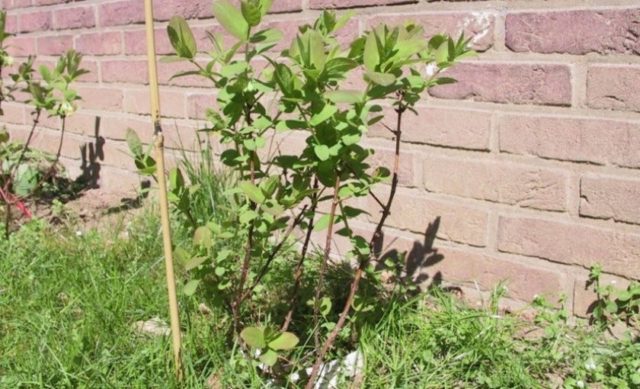
The berry in the cold Leningrad region is best planted on the south side of the building
In order for honeysuckle to grow well in the cold Leningrad region, it is better to plant it in an area with bright lighting, where the sun gets in more time of the day. In the worst case, partial shade is allowed. The berry grower does not like drafts, clay and swampy soil. In such conditions, the honeysuckle will take root, but the plant will be weak, it will bring little harvest.
The landing pattern for the Leningrad region is standard. In the rows between the seedlings, a span of 1.5-2 m is left. The row spacing is made with a width of 2 to 3 m. Before planting, the site is cleared of weeds, dug up, leveled. The holes are dug up to 50 cm deep, up to 60 cm wide. The size depends on the root system of the seedling. The root of the berry plant installed in the hole is covered with a soil mixture prepared from 50% soil and 50% humus. Water the honeysuckle with three buckets of water. When the earth settles, the trunk circle is mulched with dry compost. Further care goes according to the standard scheme. The shrub is periodically watered, weeds are removed, the soil is loosened, and fed. In the fall, prepare for wintering.
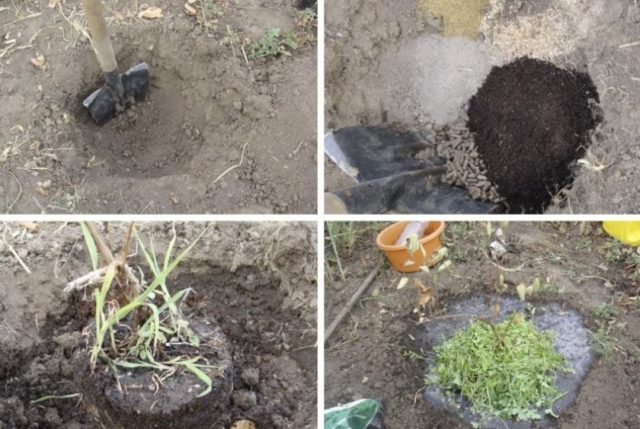
Honeysuckle will take root better if the seedling is carefully planted with a clod of earth, without disturbing the root system
A feature of growing berry crops is that common diseases rarely affect it in the Leningrad Region. This is due to the cool climate. The fact is confirmed by the doctor of biological sciences F. Teterev. But with pests, the situation is more serious. Birds love honeysuckle. The birds eat not only berries, but also leaves.
Another feature of this crop is the fact that the chemical composition of berries grown in different regions is very different. For the Leningrad Region, the sugar rate is 4.4-7.3%. The acid index is 2-3.3%. The berries are abundantly saturated with vitamin C. The indicator reaches 87%. The listed substances are more than in the fruits of honeysuckle grown in Altai or even in the Primorsky Territory.
The yield indicator is also different. Honeysuckle actively bears fruit in the Far East. Despite the natural conditions here for culture, the yield in the cool Leningrad region is 3-4 times higher.
The best varieties of honeysuckle for the Leningrad region
Not every variety of berry crops is capable of producing a good harvest if the climate is not suitable for the plant. This fact should be taken into account when buying seedlings. To help gardeners, an overview of honeysuckle varieties for the Leningrad Region with a photo, optimally adapted to the conditions of the northern strip, is offered.
Dessert
The berry has a compact crown. Honeysuckle expels branches up to 1.8 m long, but they are lowered to the ground. The total height of the bush does not exceed 1 m. In the Leningrad region, ripe berries are expected in June. Fruits are cylindrical, elongated, weighing a maximum of 1 g. The skin is blue with a light bloom. The pulp tastes sweet with a strong sourness. The fruits do not ripen amicably, it is difficult to separate from the stalk. The yield of one bush reaches 2.5 kg.
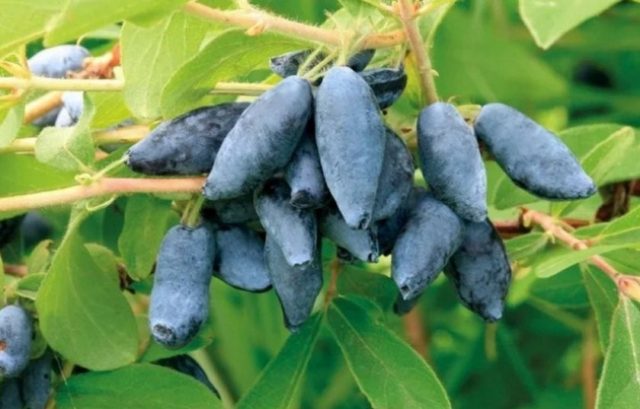
Harvesting requires proximity to pollinators
Pavlovskaya
An excellent variety for the Leningrad region with a yield of up to 2 kg per plant. The ripening time of the crop is average. The bushes usually form a non-thickened crown. The maximum height is 1.4 m. Honeysuckle bears sweet and sour fruits of blue color, but this is the color of the plaque. The skin itself is dark blue and very firm. The crop can be transported.

Berries firmly adhere to the stalk, do not crumble spontaneously
Amphora
Honeysuckle bushes grow low. In terms of ripening, the variety is considered medium. The fruits are shaped like small jugs. There is a little bitterness in the sweet and sour taste of the pulp. Fruit weight - up to 1 g. The skin is thickened, strong, blue in color with a light bloom. The yield in the Leningrad region from one bush reaches 2 kg. Fruit ripening is amicable, but they do not crumble spontaneously.

Honeysuckle in the cold climate of the area does not get sick, but often aphid or mite infestation is observed.
Tomichka
Honeysuckle of this variety in the Leningrad cool region grows in the form of a small bush. The leaves are green with a light shade. There is a slight edge on the surface of the leaf plates. Fruits with dark blue skin are shaped like a drop of water. The taste of the pulp is sweet and sour with an attractive aroma. The bitterness is completely absent. Fruit weight is maximum 0.9 g. One bush brings up to 2.5 kg of yield.
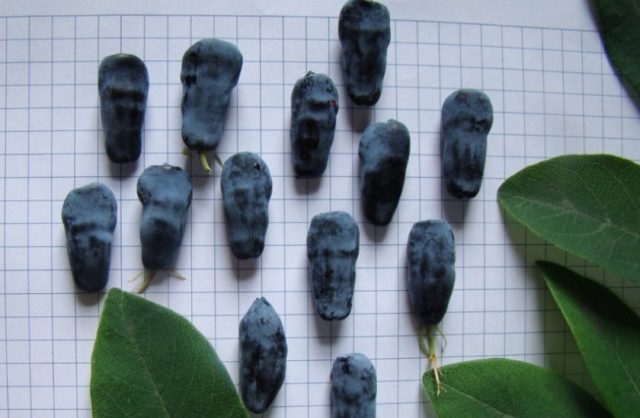
Fruits ripen quickly in the conditions of the Leningrad region
Violet
The medium late honeysuckle variety is distinguished by a thin crown of a neat round shape. The bushes grow of medium height - about 1.5 m. The branches are strong, covered with dark green foliage. Fruits grow up to 1.1 g in weight. The berries are elongated, some have a slight bend. The skin is light blue, thin but firm. The taste of the pulp is sweet and sour.
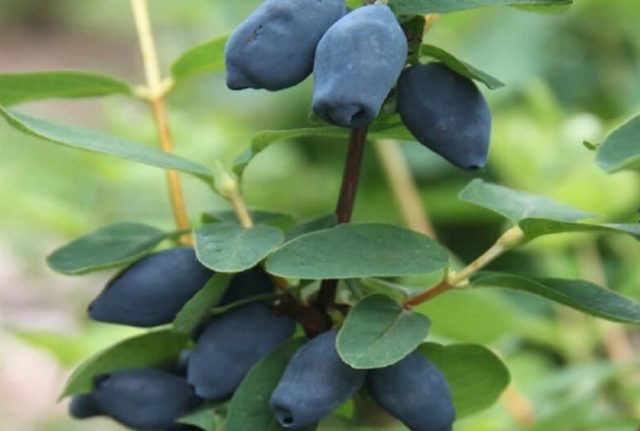
The yield from one bush reaches 1.8 kg
Viola
A tall variety in the cool Leningrad region grows a bush up to 2 m. The crown stands out for its strong thickening. It resembles an oval in shape. The color of the berries is dark blue with a characteristic light bloom. Fruits are elongated, weight reaches 1 g. In terms of ripening, the variety is considered average. The advantage is a high yield, reaching 4 kg of berries from one bush.
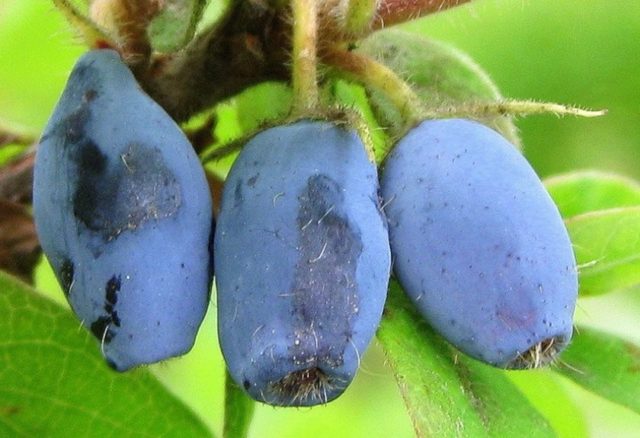
A distinctive feature is the absence of edging on the surface of large foliage
Moraine
An excellent early variety for the Leningrad Region. The bushes grow of medium height with a non-thickened crown. The berries are large, weighing about 1 g. The skin is blue, but due to the light bloom it is more blue. The shape of the fruit is elongated with visible irregularities. The pulp is fragrant. There is no bitterness in the taste, only sweetness and acidity. The yield varies from 1.5 to 1.9 kg.
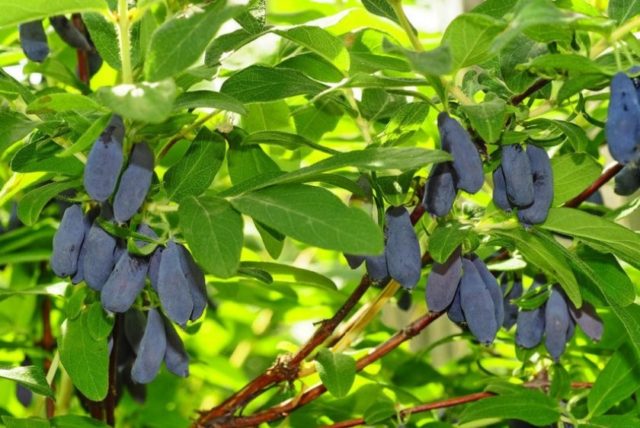
After ripening, the fruits do not crumble
Nymph
Vigorous honeysuckle grows up to 2.5 m high. The color of the berries is blue. Fruits are large, oval, slightly elongated. The mass reaches 1.1 g. The pulp has a pleasantly sweet taste with a bright aroma. There is no bitterness.Ripening of the crop begins in the last decade of June. The yield indicator is high - up to 2 kg per plant.

Honeysuckle does not shed ripe fruits
Commonwealth
The variety is considered to be of old origin. Tall shrub. Branches are spreading, strong, hanging down. The total height of the bush is up to 2 m. A distinctive feature of honeysuckle are large berries weighing up to 1.5 g. The pulp tastes sweet and sour. When eaten, bitterness is felt. The value of the fruit is in a thin skin. It is practically not felt during chewing. One bush in the conditions of the Leningrad region is capable of bringing 2.5 kg of harvest.

By the timing of ripening, honeysuckle is considered early
Leningrad giant
By the name of the variety, it is already possible to determine its zoning. Tall bushes build up a powerful crown of medium density. The height of an adult honeysuckle reaches 2 m. The branches grow even without bends. Large foliage has an elongated shape, there is an edge on the surface. The skin is dark blue with a light bloom, thin, but quite firm. There is no bitterness in the pulp, only acidity and sweetness are felt. Up to 5 kg of the crop is harvested from one bush in the Leningrad Region.
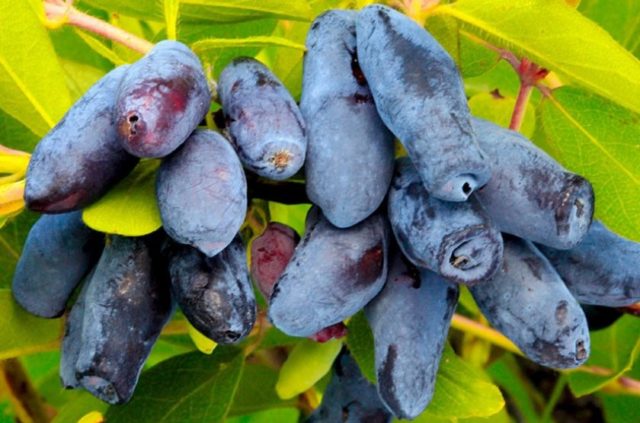
The mass of one berry reaches 4 g
The listed varieties of honeysuckle are suitable for the north-west of the Leningrad region and other areas with a similar climate. The culture is well adapted, yields a stable harvest with decent care.
Planting and care of honeysuckle in the Leningrad region
The culture takes root well and requires easy maintenance. Even a novice gardener can grow honeysuckle. When there are clear definitions with the variety, the seedling is purchased, they start planting.

Despite the cool climate of the Leningrad region, it will not be difficult to grow honeysuckle here.
Landing dates
The optimal time for planting is considered to be the period from August to November. During this time, honeysuckle is at rest. Spring planting is not recommended. Culture awakens early. In March, you can already see the swelling of the kidneys. If you do not have time to plant the bush before this time, it may start to hurt. Difficult adaptation to new conditions will take place.
Selection and preparation of the landing site
The choice of the place is a little stipulated in the peculiarities of growing. In addition, it can be noted that honeysuckle grows well on fertile sandy loam soil. Neutral acidity is optimal. The plant does not like stagnant water. If the underground water layers lie above 1.5 m, honeysuckle may not take root here.
Honeysuckle planting rules in the Leningrad region
Pits for planting a berry plant are dug in three weeks. At the bottom, it is optimal to organize drainage. The soil mixture for backfilling is made according to the above method: equal parts of the earth and humus. However, experts advise a different composition. Add 30 g of superphosphate and potassium salt to a bucket of humus and black soil.
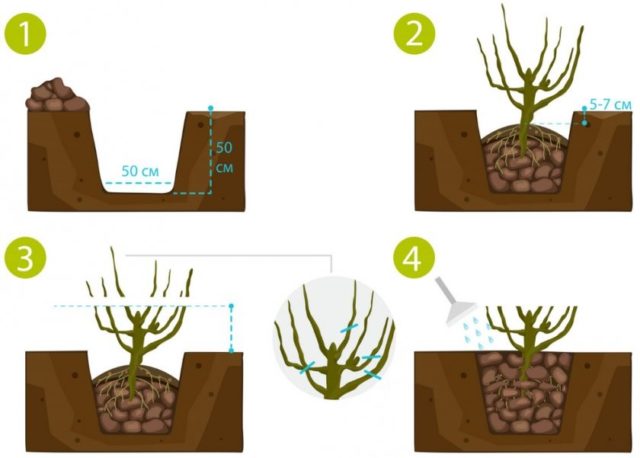
After planting, the seedling requires shortening the branches and abundant watering
A couple of hours before planting, the honeysuckle roots are soaked in water with the addition of any growth stimulant. The seedling is placed in a hole with the root system on a tubercle formed from the soil. After falling asleep, abundant watering and mulching of the trunk circle is required.
Watering and feeding
There will be no problems with watering the honeysuckle. It is enough to do this five times per season. If the summer is hot in the Leningrad region, then the number of irrigations is increased. Warm water is poured directly under the root. Honeysuckle loves pouring over the crown with sprinkling, but not during flowering. When watering at the root, a bucket of water is enough.
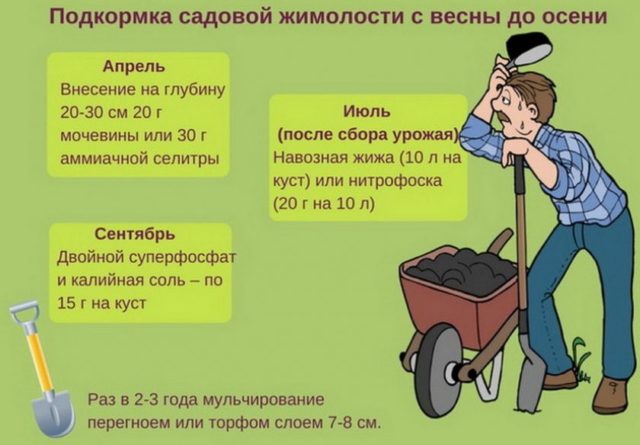
To obtain a good harvest, top dressing is applied throughout the entire growing season.
The first feeding is carried out in the third year from the moment of planting the seedling. In the spring, the bush is watered with a solution of 2 tbsp. l. urea in a bucket of water or add 10 kg of rotted humus.With the appearance of buds and berries, the bush is poured with a bucket of water with 1 liter of water dissolved. The berry is fed for the third time in the fall. The trunk circle is covered with a mixture of 5 kg of compost, 40 g of superphosphate with the addition of 100 g of wood ash.
Pruning
The first pruning is carried out immediately after planting the seedling. From the third year of life, the procedure is resorted to carefully. Remove all root growth, cut off excess branches that thicken the crown. Only five strong shoots are left. Sanitary pruning is carried out annually in the spring. Get rid of damaged, frozen and thin branches. But the main pruning is best done in the fall. In the spring, honeysuckle wakes up early, and this procedure traumatizes it. Anti-aging pruning is done every 7-10 years. For this, old branches are gradually removed, and young shoots are left to develop.
In the video, more about pruning the berry:
Wintering
In the climatic conditions of the cool Leningrad region, the culture hibernates without shelter. In the fall, it is enough to remove the leaves from under the bushes, apply top dressing and prune. For reliability, the trunk circle can be covered with earth, forming a mound. The embankment will protect the root system during severe frosts.
Reproduction of honeysuckle in the Leningrad region
If the neighbors have honeysuckle growing on the plot, it is not necessary to buy seedlings somewhere. There are many ways to breed a berry plant. It is enough to take cuttings, seeds from friends, ask them to make layers or separate the bush.

Seed propagation is considered difficult and unpopular.
To grow seedlings from seeds, a soil mixture is prepared. Mix two parts of humus, earth and one part of sand. The soil mixture is poured into boxes, the seeds are planted to a depth of 1 cm. The crops are covered with foil, germinated like ordinary seedlings.
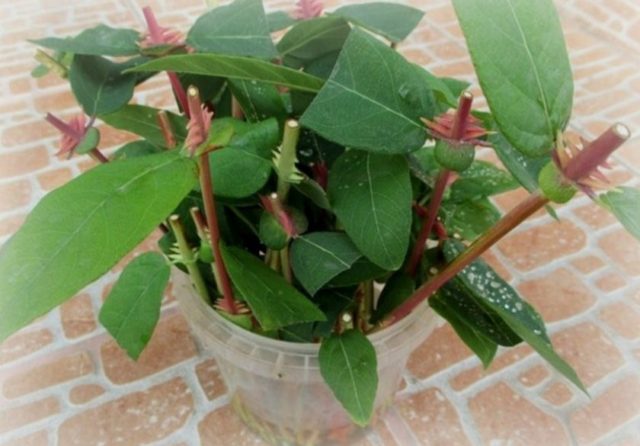
The easiest way to propagate honeysuckle is cuttings.
Lignified cuttings for propagation are cut in autumn or early spring. Regardless of the time of collection, rooting is carried out in the spring in the ground. The workpieces are stuck into the ground at an angle so that one bud remains on the surface. Water regularly to maintain constant humidity.
Green cuttings are germinated in water or soil. In the second option, a greenhouse is organized over the plantings. Remove it after the branches take root. There is another option for using combined cuttings, in which one or two shoots are green on the side, and the lower part is lignified, about 2 cm long. This breeding option is practiced in the summer.
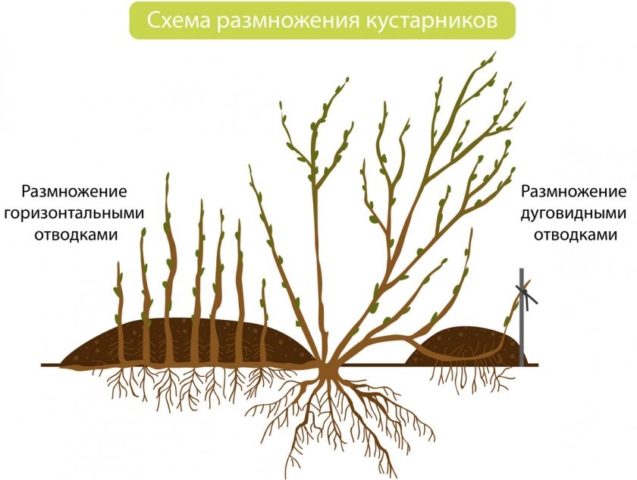
Layers allow you to get strong seedlings
To obtain layering, honeysuckle branches are bent to the ground, covered with soil and constantly watered. When rooting occurs, the lash is separated from the mother bush. The seedling is transplanted to a new place in the fall.
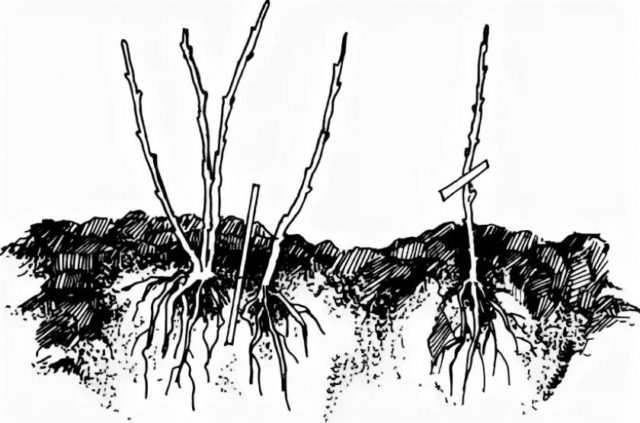
Dividing a bush for a plant is painful
The method of reproduction by division is based on digging up the entire honeysuckle bush of five years of age. Several shoots with full-fledged roots are separated from it and planted in permanent places of growth.
Diseases and pests
Of the diseases in honeysuckle, spotting is most common. You can find out the ailment by the spots on the leaves of red color with different shades. This is due to high humidity and strong thickening.
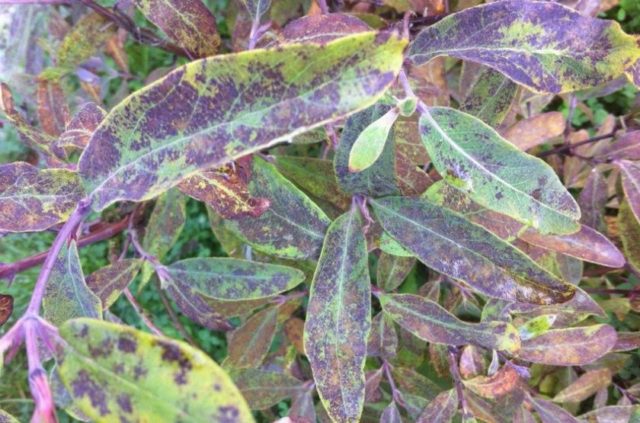
Spotting is most often seen in honeysuckle with improper care.
Of other diseases, powdery mildew, black fungus, and tuberculariosis are less common. On the branches of honeysuckle, aphids, honeysuckle fingerfly, and scabbard often appear. In order not to be left without a crop, it is recommended to carry out preventive spraying with drugs.
Conclusion
Planting and caring for honeysuckle in the Leningrad region is a simple procedure. A minimum of labor is required from the gardener. For this, the culture will thank you with delicious berries that you can just eat, cook jam, compotes.








